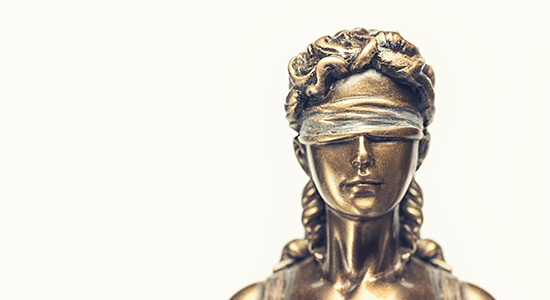
Sep. 5, 2018 – The West Virginia judiciary made national headlines recently, as three state supreme court justices are facing separate impeachment trials for alleged maladministration, corruption, and incompetence, among other alleged conduct.
Last month, on Aug. 13, the West Virginia House of Delegates passed 11 articles of impeachment against four sitting justices, including the chief justice. The articles largely stem from office renovations deemed lavish and a waste of state taxpayer funds.
One justice, Robin Davis, already resigned. Another justice, Allen Loughry II, is currently suspended and facing federal charges. A grand jury charged Loughry with 25 counts of alleged mail and wire fraud, false statements, and witness tampering. The charges allege Loughry used a government-owned vehicle and government property for personal use.
As Loughry was arraigned on a new set of charges last month, his former colleague, Justice Menis Ketchum, was pleading guilty to wire fraud in the same courthouse.
Ketchum, who was facing an impeachment hearing in July before he resigned, admitted to using a state-owned car for golf outings and charging the government’s gas card.
The West Virginia Senate will hold impeachment trials for Loughry and two other justices, accused of “unnecessary and lavish spending” on renovations and remodeling of supreme court offices, including a $20,000 rug and a $30,000 blue suede couch.
The articles also charge the court’s chief justice, Margaret Workman, with allegedly signing contracts to pay senior status judges above the statutory limited maximum.
If the three judges are ousted, the state’s governor can appoint an entirely new court, since the five-member court already has two vacancies that must be filled.
Impeachment, at both the federal and state level, puts the fate of judges and justices in the hands of the legislative branch. Since adoption of the U.S. Constitution, 19 federal officers have faced impeachment proceedings and 15 of them were judges. In Wisconsin, only one judge has faced impeachment by the Wisconsin Legislature.
Federal Impeachments
Under the U.S. Constitution, the U.S. House of Representatives has the “sole Power of Impeachment” and the U.S. Senate has the “sole Power to try all Impeachments.”
 Joe Forward, Saint Louis Univ. School of Law 2010, is a legal writer for the State Bar of Wisconsin, Madison. He can be reached by email or by phone at (608) 250-6161.
Joe Forward, Saint Louis Univ. School of Law 2010, is a legal writer for the State Bar of Wisconsin, Madison. He can be reached by email or by phone at (608) 250-6161.
Any civil officer may be removed from federal office, by impeachment, for conviction of treason, bribery, and other high crimes and misdemeanors. In total, eight federal judges in the last 230 years have been found guilty of impeachment charges and removed.
The most recent was Thomas Porteous Jr. of the U.S. District Court for the Eastern District of Louisiana, unanimously impeached on all four articles against him in 2010.
Porteous was accused and convicted of corrupt financial relationships with attorneys, accepting bribes, and perjury in his personal bankruptcy case.
Before the 1980s, the country enjoyed a 50-year period without a single impeachment trial against a judge or other civil officer. That changed in 1986 when U.S. District Court Judge Harry Claiborne of Nevada was removed from office for tax evasion.
In 1989, U.S. District Court Judge Alcee Hastings of Florida was removed for perjury and conspiring to solicit a bribe. The same year, U.S. District Judge Walter Nixon of Mississippi was removed from the bench for perjury before a federal grand jury.
The Walter Nixon Impeachment led to a U.S. Supreme Court decision. A Senate Rule allows a Senate committee to hear the evidence and report to the full Senate, which votes on whether to impeach or not. Nixon challenged that Senate Rule, arguing the full Senate has sole power to try all impeachments, not the Senate’s special committee.
The U.S. Supreme Court, in Nixon v. U.S., 506 U.S. 224 (1993), held that Nixon’s claim was a non-justiciable political question and courts cannot review impeachments because impeachment power is exclusively granted to the legislative branch.
“Nixon’s argument would place final reviewing authority with respect to impeachments in the hands of the same body that the impeachment process is meant to regulate,” wrote Chief Justice William Rehnquist in the Nixon decision, referring to the judiciary.
Ten years after the Nixon impeachment, the nation watched as the second U.S. President in the country’s history faced impeachment in 1999. President Bill Clinton, like President Andrew Johnson in 1868, was acquitted on two impeachment articles.
Chief Justice Rehnquist, born in Milwaukee, presided over the Clinton Impeachment. Rehnquist was appointed to the bench by President Richard Nixon, who would have faced an impeachment trial over the Watergate scandal if he did not agree to resign.
Interestingly, Emmet T. Flood served as President Clinton’s independent impeachment counsel. Flood is now on President Donald Trump’s legal team.
Impeachment in Wisconsin
The Wisconsin Constitution (Art. VII, Section 1) governs impeachment of civil officers in Wisconsin, including judges. The state Assembly has the power to impeach “for corrupt conduct in office, or for crimes and misdemeanors,” by a majority of all members.
The state Senate holds impeachment trials, and no person can be convicted without the concurrence of two-thirds of the members present. The Senate has 33 members.
The Legislature also has the power to remove judges “by address,” under Art. VII, Section 13, which says “[a]ny justice or judge may be removed from office by address of both houses of the legislature, if two-thirds of all the members elected to each house concur therein.” The justice or judge must have an opportunity to be heard.
Wis. Stat. section 17.06 confirms the power of the Legislature to impeach civil officers and to remove justices or judges “by address.” It also clarifies what it means to remove someone “by address.” A document is the “address” by the Legislature.
Per Wis. Stat. 17.06(2), the address document “specifies charges against a judge alleging misconduct or that the judge is not physically or mentally qualified to exercise the judicial functions of the judge's office.” The judge has an opportunity to defend.
Thus, whereas impeachment requires evidence of corrupt conduct or crimes, the removal statute is not so limiting. Removal by address was, wrote Ellen Langill in 1998, “in effect, a more rapid and summary method of removing an official without the slow deliberations of an impeachment hearing and trial,” and rarely used in American history.
Impeachment and removal grant Legislative authority to oust judges, but another provision of the state constitution also allows judges to be recalled by voters.
Article VII, Section 11, adopted in 1977, also grants the Supreme Court power to reprimand, censure, suspend, or remove for cause or disability justices and judges in Wisconsin. The Wisconsin Judicial Commission, created in 1978, hears those cases.
Thus, while the Legislature has the power to impeach and remove judges, that power is largely ceded to the judiciary’s forum for disposition of complaints against judges. Still, the West Virginia impeachments have bypassed that state’s judicial commission.
Hubbell and Stolen
Cursory research reveals just one recorded instance of impeachment or removal of a judge in Wisconsin. In 1853, Milwaukee Judge Levi Hubbell faced impeachment but was ultimately acquitted. In 1927, Judge Ole A. Stolen sought refuge in Wisconsin’s provisions on impeachment and removal, but his arguments were unsuccessful.
Stolen was a judge on the superior court for Dane County when he took loans from known and notorious bootleggers in Madison, who then appeared before him in court.
Members of the Dane County Bar Association petitioned the Wisconsin Supreme Court to investigate whether Stolen should be disbarred and removed. Stolen argued that, under the Wisconsin Constitution, only the Legislature could impeach or remove him.
But the Supreme Court said the constitution’s removal and impeachment provisions did not apply to him because the superior court was created by the Legislature. The constitutional provisions only applied to circuit and supreme court judges.
The court disbarred Stolen, but not before making an oral reprimand against the 60 Dane County Bar members who filed the petition seeking his disbarment. The court was not pleased to receive a petition, or brief, that left something to be desired.
“The brief itself did not pretend to examine or analyze the evidence, and so far as a discussion of the law was concerned, it did no more than to cite a few cases upon the most fundamental propositions,” Justice Walter Owen. “If this was done deliberately and with the purpose of influencing the court, it was reprehensible.”
In dissent, Justice Franz Eschweiler did not agree with the public scolding of the Dane County Bar. “I think that this department of the government might well have allowed it, without sob or sound, to drop into the oblivion to which it is so vigorously consigned.”
That leaves Levy Hubbell, who was elected circuit judge in Milwaukee in 1848 and served as chief judge of the Wisconsin Supreme Court, which was comprised of the state’s five circuit court judges. In 1853, a separate Supreme Court was created.
Edward G. Ryan, who later became chief justice of the Wisconsin Supreme Court, served as a special prosecutor in the impeachment hearings against Hubbell, accused of accepting bribes and hearing cases in which he had a financial stake in the outcome.
He was also charged with misusing court funds, providing confidential information to select litigants or their lawyers, and “debauchery.” Yet the five-day impeachment trial ended as it began, with accusations but no impeachment conviction by the Senate.
Jonathan Arnold, a prominent criminal defense lawyer in Milwaukee, had persuaded enough Senate members that Hubbell should not be convicted on the charges.
In 1998, Langill reflected: Arnold had concluded that “the whole impeachment attempt was a reflection upon the system, not upon Hubbell who merely played by its rules.
“It was a witch-hunt attempt by those jealous of Hubbell’s achievements ‘to drive him from the position bestowed upon him by the people.’”
